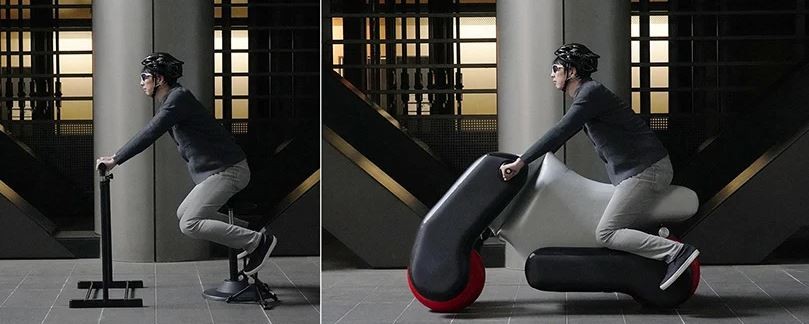
by Elena Gorgan from https://www.autoevolution.com
Imagine a situation in which you can customize your dream vehicle based on your preferred position of riding. Then, imagine being able to further customize that vehicle and have it easily managed, carried and stored, without having to worry about storage or whether you’re strong enough to carry it. A POIMO would be just right for what you’re looking.
POIMO stands for “POrtable and Inflatable MObility,” a concept by Mercari R4D. The first iteration of the POIMO was unveiled earlier this year and now designers, in collaboration with the Kawahara and Niiyama labs from the University of Tokyo, have come up with the second model. It’s the customizable inflatable vehicle mentioned above, and it could be either an electric motorcycle or a manual wheelchair.
The idea is to create a means of transportation that would be easy to carry and put together, offer none of the downsides of having a solid frame related to parking or storage, and still be as efficient. Being customizable from a single picture of the rider’s posture would also be a plus, one that fixed-framed vehicles won’t have.
Designers say that everything on the bike would be made of the same inflatable material, even the wheels. That may be the case with the manual wheelchair, but we assume an electric motorcycle would require at least some components not made from fabric, no matter how durable it was.
Riding on inflatable wheels also seems a strange proposition for a motorcycle, but the designers promise you won’t feel the difference between this one and the real thing. In theory. Let’s not even get into how safe this would be in traffic. That balloon material will absorb shocks and bumps alright, but it will still be like sailing on an inflatable swan into a speedboat convention.
In case you’re wondering how this would work, the theory is this:
“For example, when designing an electric motorcycle type POIMO, the user first imagines the motorcycle he wants to make and then poses to ride it using a chair or the like,” the designers explain.
“The software extracts 3D information of posture from it, automatically designs a vehicle of shape and size according to the user’s pose, and displays it on the screen as a 3D model. Based on the proposed design, users can further customize the steering wheel, seat position, etc. at this time, the design parameters are automatically adjusted by the software so that the strength, stability, and operability are not impaired. The final design that has been adjusted is output as data that can be ordered as it is.”
One could argue that sitting on a motorcycle (or a bicycle, for that matter) has little to do with sitting on a chair as regards body posture, so even if you were to design an inflatable two-wheeler using this customizable method, you have no guarantee for a comfortable ride. But the idea behind the project is to try and offer customizable vehicles – and it stops at that. “Even if you are not an expert, you can easily design personal mobility,” the designers say.
An inflatable vehicle would also come with considerable advantages in terms of convenience. In crowded urban areas where it would be used, like Tokyo, people live in small apartments where they don’t have space to store a bicycle, or they can’t afford risk having their motorcycle stolen from the parking lot. Neatly packing your ride into your backpack after you get to your destination would surely do away with this issue.
Available at the bottom of the page is a video demonstration of the new POIMO iteration, the electric motorcycle and the wheelchair. They both look ridiculous, to be sure. But it’s important to stress – and remember – that this is research into a concept that serves as possible learning experience, and not an actual product that will be sold as such. The research will be presented at UIST 2020.
